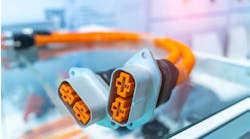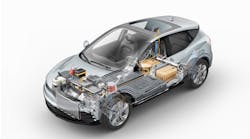Despite the unforeseen nature of 2020 and the economic hit, many auto repair shop owners have reported some of their best sales days ever; when Ratchet+Wrench sent out a survey to gauge reactions to COVID-19 in June, 92 percent had an overall positive outlook for business for the next five years.
How, in a time of turmoil, are some shop owners thriving? A forward-thinking approach may be the answer, with a focus on technology at the root.
“In this business, you better stay relevant or you will become irrelevant, and that goes with technology,” Steve Rozansky, owner of Friendly Auto Centers in Mesa, Ariz., says. “You have to stay current with what’s going on or you will be out of business.”
Technology is a tool and shop owners that invested heavily in it before the pandemic hit found themselves already set up for many of the needed adaptations. Those that were not equipped were forced to either adapt or fall by the wayside.
“I don’t think that the pandemic is a “game changer.” I hate those words. People have used them as a crutch, an excuse—I’ve used it as an opportunity, ” Steve Mancinelli, owner of Mancinelli’s Auto Repair in Denver says. “We had an opportunity after 9/11, after the financial crash, after Cash for Clunkers—you name it. This is no different than anything else. It’s just about making sure to pay attention to what customers want and need and make constant adjustments.”
It seems many shop owners have followed suit: In Ratchet+Wrench’s COVID-19 follow-up survey, 68 percent reported making changes to the processes at their shops.
From reaching customers to selling jobs to keeping staff up-to-date on training, here’s a look at how technology has helped shop owners get through the year 2020, with data from the 2020 Ratchet+Wrench Industry Survey to showcase the need for change during a time of crisis.
Online Presence
One of the largest obstacles standing in the way of customers coming in the door was whether or not the doors were open. With essential business designations and stay-at-home order being vague, many potential customers were unaware of what was actually open and able for them to visit. Because of this, shops had to figure out a way to get the word out and meet customers where they were—online.
Winning Website
—
A look at how often shops were updating their websites pre-COVID
Within the last year: 49%
1 year: 16%
2 years: 10%
3 years: 5%
4 years or longer: 5%
My shop does not have a website: 15% .
Website
Google is one of the most popular ways for new customers to find a new auto repair shop to visit, and having a strong website is key to getting to the top of those searches and attracting them. Many shop owners, including Mancinelli, updated their websites immediately to address the safety precautions that were being taken, the hours that they were open, and the specials that they were running, like the COVID-19 cleaning special that Rozansky put on Friendly’s Auto’s website. Mancinelli updated his site immediately. All he had to do was alert his website provider to the changes he wanted made and it was up and ready shortly.
In a typical year, Mancinelli says he updates his website two or three times. When COVID-19 hit, he went through each page to make minor adjustments and added a main page “bubble” that popped up and alerted customers to the safety precautions and that the shop was open. Typically, he says the content stays the same and the only updates that are made are on the blog. Frank Scandura, owner of Frank’s European Service in Las Vegas, also had a COVID-19 main page pop up for customers, which he kept up for 90 days after the pandemic first hit.
Social Media
Customers—new and returning—can also be reached through social media. Mancinelli, who typically posts two or three times per week on Facebook and Instagram, updated the types of posts to address what customers were curious about. He took pictures of the different safety precautions, such as his techs wearing masks and gloves, and posted those.
Rozansky, who is also on Facebook and Instagram did the same and shared posts about being open for business, but also used his podcast, Drive Friendly with Steve and Felecia (Rozansky co-hosts with his wife, Felecia), to connect with customers.
“We went online all of the time,” Rozansky said of his approach to reaching customers during the height of the pandemic. “I’d say we did more posts on social media than usual.”
Most Popular Platforms
—
A look at where auto repair shop owners are marketing on social media
Facebook: 81%
Google My Business: 58%
Instagram: 26%
Twitter: 20%
LinkedIn: 18%
None: 15%
Pinterest: 3%
Snapchat: 2%
TikTok: 1% .
Customer Interaction
The days of shaking a customer’s hand, that customer waiting in the lobby, and walkaround tours of the vehicle to explain the work needed are gone. For how long is anybody’s guess, but this industry is still built on customer interaction, so shop owners needed to adapt and find ways to cultivate trust with their customers while making it safe and convenient for them to get their vehicles serviced.
Vehicle Pick-Up/Drop-Off
“People don’t want to wait for their cars,” Rozansky says of customer expectations during COVID-19.
Along with Mancinelli and Scandura, he offered vehicle pick-up and delivery services before the pandemic hit, which put them in a good position, as many customers were uncomfortable leaving their homes and many states had social distancing restrictions that would not allow customers to wait in a lobby.
“We did a push on our website to let people know that we were doing this,” Mancinelli says of the service.
Mancinelli also sent an email blast to his customer base to let customers know it was being offered.
Scandura says that people are taking advantage of this service “now more than ever.” He also offers a key lock box, so you can drop off your vehicle, stick the keys securely in the box and then pick up the keys and the vehicle when it's ready by using an agreed-upon code. Scandura says most of his customers prefer the no-contact pick-up and drop-off option.
When it comes to shuttle services, Scandura has taken a page out of rideshare companies like Uber and Lyft and is modeling his shuttle to mimic their safety practices, such as wearing masks.
Digital Vehicle Inspections
Shockingly, according to the 2020 Ratchet+Wrench Industry Survey, less than half (47%) of shops utilize digital vehicle inspections. Not using one may put you at a disadvantage, especially right now. Joelle Pollack, director of sales and marketing for NAPA AutoCare, says that during the pandemic, NAPA customers that were already using digital vehicle inspections were able to get back on track in just a few weeks.
“Some members weren’t interested [in DVIs] at all, this was the little nudge that they needed,” Pollack says. “Overall, they’ve seen positive results and it has been a part of their new norm.”
Social distancing makes vehicle walkarounds very difficult. That doesn’t mean that customers will just trust you blindly, though. When the pandemic hit, shop owners that already used videos and pictures were already in a prime spot because they had the tools in place to connect remotely already.
“We had a lot of shop owners that were very prepared without even knowing it for this new normal,” Jason Rainey, vice president, NAPA AutoCare, says.
Scandura is a firm believer in inspections, otherwise, customers will go to “Mother Google,” which opens the door to a lot of misinformation. Digital vehicle inspections put the shop in control and allow shops the ability to share the correct information with customers. You can send videos, pictures and notes remotely, explains Scandura, which is great during any time but especially during a time when face-to-face interaction is undesirable.
“We’re educating them,” Scandura says of the importance of digital vehicle inspections. “People don’t buy parts and pieces, they buy trust.”
Digital Vehicle Inspection's Impact
Showing and not telling really pays off.
Customers really do appreciate being able to see what’s going on with their vehicles and shop owners are catching on, although it’s still not mainstream. In 2016, using a digital inspection sheet was rare, with only 33 percent reporting that they used such a system. In 2020, the number has risen to only 47 percent.
If you still don’t utilize such a system, you may want to rethink it. Shops that utilize electronic inspection sheets significantly outperformed those that didn’t when it comes to making a sale.
Utilize Electronic Inspection Sheet
Closing ratio of 70% or higher: 46%
Does Not Utilize Electronic Inspection Sheet
Closing ratio of 70% or higher: 9%
Online Payment
One adaptation that Mancinelli made after COVID-19 hit was the ability to pay for services on the website. Before the pandemic, you could send a link through text or have people pay over the phone, but paying through the website wasn’t available, only because he had never really given it much thought. The process for getting it up and running was easy and happened within a matter of hours. He contacted his website provider and told them what he wanted done and he was all set.
Mancinelli says that he will continue to offer this option when operations return to normal because it’s a matter of convenience.
“The more convenient the experience, the more people will do business with me,” Mancinelli says.
Scandura estimates that, at his shop, there was a 10 percent uptick in contactless payment during the pandemic.
Business Tools
In March, 94 percent of shop owners surveyed by Ratchet+Wrench saw a decrease in business. Because of this, many businesses had to adjust their business models. Shop owners took advantage of the time to catch up on building maintenance or training. Others were forced to look at staffing and make layoffs or furlough employees. Others closed down for a period of time. Whatever the case, April and May looked very different for most auto repair shops. Here’s a few ways that small business owners adjusted through technology.
Virtual Training
Rainey was on a plane when he found out that the NAPA Expo in-person training event was cancelled.
“That was three years of aggressive planning—20,000 customers coming and it was just gone,” Rainey says.
When the coronavirus hit, events were immediately cancelled, with some rescheduled, some cancelled altogether, and others—like Rainey’s NAPA team—considering an alternative to connect with customers.
“Why can’t we use Zoom and a virtual atmosphere to get in front of our customers?” Rainey says.
Rainey says the NAPA team reached out to Kukui, since they had experience hosting virtual events already and in six weeks, NAPA put on the NAPA Virtual Conference, a two-day event.
Kathleen Jarosik, owner of Xpertech Auto Repair in Englewood, Fla., was one of the attendees.
“I remember watching the chat box and seeing people reach out to each other,” Jarosik says. “There were service advisors and staff that wouldn’t have normally been able to go or afford it [attending a training event].”
Not only that, but you can watch the training whenever you want and you no longer have to worry about prior commitments or selecting a “track” and missing out on a session. Rozansky bought a suite of videos through AVI and accesses Bosch’s certified repair center program free online training and now has training for his whole staff accessible whenever he wants, which is a welcome change from the experience he had with in-person training.
“Local training has always taken place after work. You put in a 10-hour day, you’re dirty, then [you go to training] you have a crappy meal that’s fattening and heavy and you sit in a classroom for three hours and the majority end in a sales pitch,” Rozansky says of his experience.
Mancinelli has also taken advantage of online training, attending CARQUEST’s webinars and other vendor offerings, during the pandemic.
“I think [virtual training] has gotten better since time has passed,” Mancinelli says. “A lot of these folks weren’t prepared for it but they saw there was a need in the industry and they learned as they went along with it.”
Training Rank
A breakdown of the most popular training that shop owners and staff are attending
Type of Training Respondent and/or Team Attend:
Part/equipment supplier: 63%
Industry association: 53%
Part/equipment manufacturer: 48%
OEM-specific: 35%
ASE: 31%
None: 9%
Training Time
A look at how often shop owners were attending and sending staff to technology training
Time Owner Spent at Tech Training
Never: 11%
Within last 5 years: 21%
Annually: 31%
Quarterly: 23%
Monthly or more: 13%
Time Staff Spent at Tech Training
Never: 13%
Within last 5 years: 16%
Annually: 24%
Quarterly: 32%
Monthly or more: 15%
Communication Devices
Rozansky says that between his cell phone and his shop management system (Tekmetric), he can run his shop remotely, which can come in handy during a time when people who are sick have to quarantine for two weeks. Rozansky has not had to do that, but being able to stay connected to the business at all times gives him peace of mind.
Rozansky has computer stations all over his shop, and his techs are all able to use tablets and cell phones to check on the status of vehicles and communicate with one another. It’s also been helpful to be able to connect with customers.
“You can FaceTime or Zoom someone and they can walk you through that issue,” Rozansky says.
Whether in the midst of a pandemic or during a much needed vacation, technology can help shop owners lead from afar.
Popular Software Platforms
The most common type of front of shop technology used
Accounting software: 79%
Electronic management system: 78%
Electronic estimating system: 77%
CRM software: 49%
Electronic inspection sheet: 47%
Electronic KPI software: 36%
Electronic customer service index software: 28%
*Courtesy of the 2020 Ratchet+Wrench Industry Survey
Although nobody can predict the future, those that have a forward-thinking approach and continue to evolve to fit the needs of their customers and anticipate what’s to come are those that are better equipment to deal with the unknown—such as a pandemic. Technology is key when it comes to this, so make sure to pay attention to the trends, invest where you need to, and get the necessary training.



